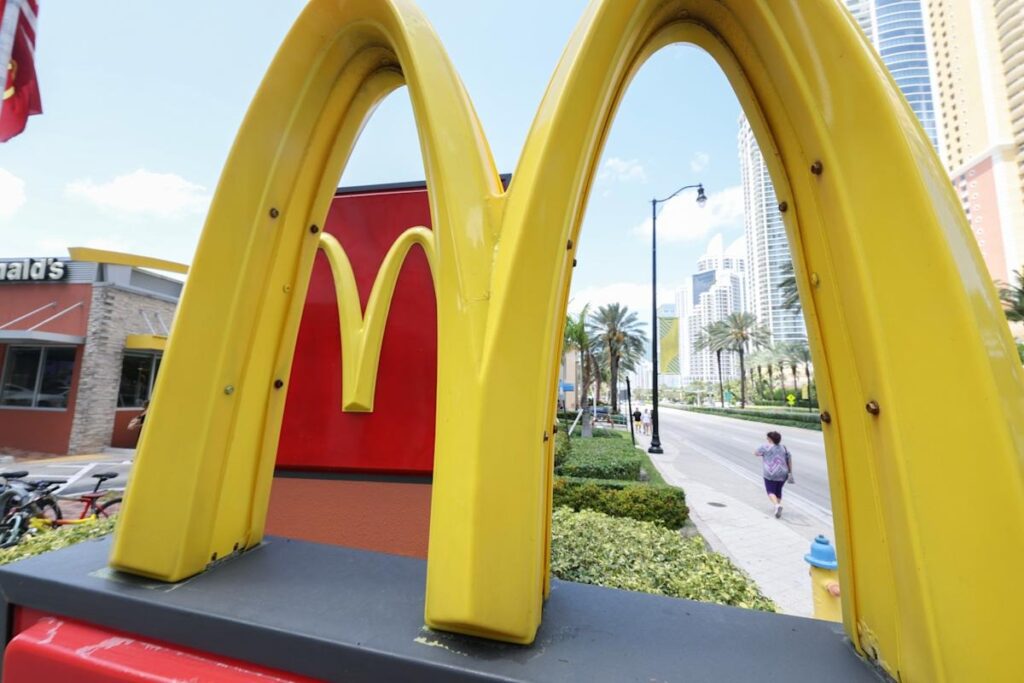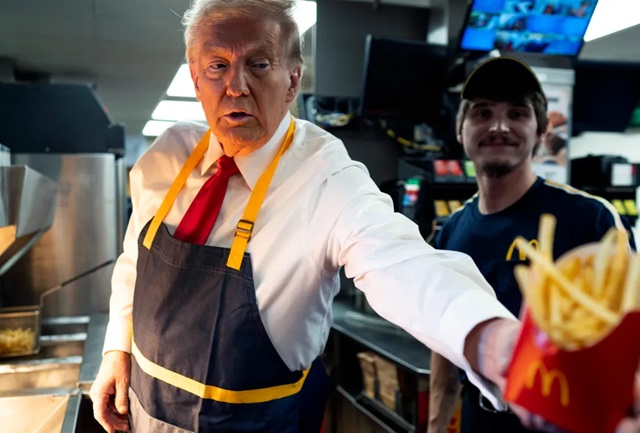It was a cold earnings morning at McDonald’s headquarters in Chicago when the numbers came in — numbers that would send ripples through Wall Street and stir conversations across American households.
A 3.6% drop in same-store sales in the United States for the first quarter of 2025 — the worst since the pandemic lockdowns of 2020. For a company that feeds over 60 million customers daily worldwide, this was more than a hiccup. It was a red flag.
Sales Performance: Expectations vs. Reality
It was supposed to be just another cautious quarter for McDonald’s — a minor correction in consumer behavior, a blip on an otherwise steady post-pandemic recovery.
Wall Street analysts had projected a 1.7% decline in U.S. same-store sales, citing inflationary pressures and minor shifts in consumer spending habits. But when McDonald’s released its earnings for Q1 2025, the results stunned the market: a sharp 3.6% drop in same-store sales — more than double what was expected.
This wasn’t just a miss. It was a message.
To understand the gravity of this decline, one must rewind to the second quarter of 2020 — the darkest days of the COVID-19 pandemic.
That quarter, McDonald’s U.S. sales plunged 8.7%, driven by lockdowns, shuttered dining rooms, and unprecedented consumer uncertainty.
What made Q1 2025 so jarring is that there was no pandemic this time. No stay-at-home orders. No supply chain crisis. Yet the numbers fell — and sharply.
In the nearly five years since the pandemic crash, McDonald’s had been on a path of recovery:
In 2021, U.S. same-store sales grew 13.6%, marking a strong rebound year.
In 2022, the pace slowed slightly, but remained positive at 5.9%.
2023 and 2024 brought more modest gains — 3.1% and 2.7% respectively.
This made the Q1 2025 decline not only unexpected — but a clear reversal of momentum.
Investors reacted swiftly. McDonald’s stock (NYSE: MCD) fell by over 7% in after-hours trading, wiping out billions in market capitalization overnight.
Some analysts at firms like Morgan Stanley and Barclays downgraded their outlooks, warning of a “consumer-driven earnings risk” spreading across the broader quick-service restaurant (QSR) sector.
And perhaps most troubling of all — traffic counts, a key performance indicator in the fast food industry, were down across nearly all U.S. regions, not just in low-income zip codes.
So what changed? Why are the Golden Arches — once a beacon of affordability and comfort — now struggling in their own backyard?
This wasn’t just a business story anymore. It was a cultural shift — a mirror reflecting deeper economic anxieties in American life.

Why Are McDonald’s Sales Falling?
When McDonald’s CEO Chris Kempczinski addressed investors after the Q1 2025 earnings call, he didn’t hide behind corporate jargon. His words were blunt: “Consumers are feeling uncertain.”
But the internal data told an even more sobering story — one that reflects not only the health of McDonald’s but the pulse of the American economy.
The Vanishing Middle Class at the Counter
The most telling trend? A nearly twofold drop in foot traffic from middle-income consumers, who for decades formed the backbone of McDonald’s daily business.
According to company reports and third-party tracking firms like Placer.ai, store visits from this group have declined by 19% year-over-year — a number that caught even seasoned analysts off guard.
In the 2010s, this demographic was McDonald’s sweet spot: working families, suburban commuters, and budget-conscious students. But in 2025, that consumer group is feeling the pinch of:
Persistent inflation, with food-at-home prices rising 4.1% year-over-year.
Stagnant wage growth, with real disposable income for middle-income Americans falling by 2.6% since mid-2023.
Rising debt — with credit card delinquencies hitting a 12-year high, according to the Federal Reserve.
Low-Income Customers Have Already Disengaged
Even more alarming, low-income diners — once McDonald’s most loyal customer base — have significantly pulled back. Analysts at Cowen & Co. reported that store visits from households earning under $35,000 per year have declined by 23% since late 2023.
These customers aren’t just cutting back on McDonald’s — they’re cutting out entire meals. According to a survey by CivicScience, 34% of low-income respondents said they’ve skipped breakfast in the last week due to financial stress. For a company like McDonald’s, which built much of its growth on the convenience and affordability of breakfast offerings like the Egg McMuffin and Hash Browns, this is a dangerous shift.
Breakfast — Once a Daily Habit, Now a Luxury?
Historically, McDonald’s dominated the fast-food breakfast game. But morning visits dropped by 11% in Q1 2025, based on internal traffic analytics. What’s behind this drop?
Hybrid work and remote jobs have reduced commuter traffic.
More families are meal-prepping or eating at home to cut costs.
Some simply skip breakfast altogether.
What was once a $12-billion annual breakfast business for McDonald’s in the U.S. is now shrinking for the first time in over a decade.
Only the Affluent Are Holding Steady
Ironically, the only segment McDonald’s isn’t losing is one it didn’t aggressively pursue: high-income consumers. Those earning $100,000 or more annually have maintained consistent visit rates, though they represent a much smaller portion of the customer base.
Still, even they are becoming more selective. According to data from Numerator, affluent customers are spending more at premium chains like Sweetgreen or Panera, where the perceived quality justifies higher prices. McDonald’s isn’t necessarily gaining loyalty here — just clinging to relevance.
The Industry-Wide Ripple Effect
This isn’t just a McDonald’s problem. Industry-wide data shows the same cooling trend:
Chipotle reported slower growth in lower-income markets, with urban foot traffic down 8.4%.
Domino’s saw a 3.2% drop in delivery orders compared to the same quarter last year.
Starbucks has warned of a “consumer pullback,” especially in non-metropolitan areas.
Economists and market researchers agree: this is a structural reset in consumer behavior, driven by economic fatigue. After years of inflation, shrinking savings, and rising interest rates, Americans are cutting back not just on luxuries — but on convenience meals, too.
What Is McDonald’s Doing to Reverse the Trend?
Rather than waiting for the economy to rebound, McDonald’s is actively fighting back with new strategies to lure customers back.
Countermeasures in Play:
$5 Value Meal Deal : Designed to appeal to budget-conscious diners, this deal includes a sandwich, fries, drink, and sometimes a dessert — a nostalgic nod to the era of affordable fast food.
Minecraft Movie-Themed Promotions : By tapping into the massive popularity of Minecraft, McDonald’s is targeting younger demographics and families — a smart move as kids often influence parents’ dining decisions.
Expansion of 2,200 New Stores by 2025 : These are being planned primarily in emerging markets like India, Southeast Asia, and parts of Africa — regions where fast food demand is rising.
Increased Discount Offers : While promotional pricing can temporarily boost traffic, analysts warn it could erode profit margins if overused.
According to RBC Capital Markets, aggressive discounting might help the top line, but it puts long-term shareholder returns at risk.

Global Headwinds: Anti-American Sentiment on the Rise
Outside the U.S., McDonald’s faces a different — but equally concerning — challenge: growing anti-American sentiment.
In places like Northern Europe and Canada, political tensions have translated into consumer behavior:
Tariff policies from the Trump administration still cast a long shadow.
McDonald’s, as a symbol of American capitalism, is facing boycotts or declining popularity in some regions.
This geopolitical resistance adds to the company’s woes, affecting not just branding, but revenue as well.
A Brief Look Back: McDonald’s Origins and Ownership
McDonald’s wasn’t always a global behemoth. It began in 1940 as a small drive-in in San Bernardino, California, founded by Richard and Maurice McDonald. The real transformation came with Ray Kroc, a visionary businessman who turned their model into a franchise empire starting in 1955.
Today: McDonald’s is a publicly traded company listed on the New York Stock Exchange (NYSE) under the symbol MCD.
It’s owned by millions of shareholders, from large institutional investors to everyday individuals.
The headquarters remains in Chicago, Illinois — the nerve center of a $200+ billion brand.
McDonald’s Legacy in the Fast Food Industry
McDonald’s is not just a restaurant — it’s a cultural phenomenon.
A Legacy Built on Speed and Scale: Over 100 countries have McDonald’s restaurants. More than 60 million people dine at McDonald’s every single day.
Iconic offerings like the Big Mac, Happy Meal, and World Famous Fries continue to define fast food. The “Speedee Service System” and franchise model revolutionized global dining.
It remains the largest fast-food brand in the world, a title that brings both immense power and immense pressure.
Is This a Crisis or a Correction?
The decline in U.S. sales is a serious concern, but it’s not the end of the road for McDonald’s. The company has weathered many storms before — from PR scandals to economic recessions — and emerged stronger.
What sets McDonald’s apart is its ability to adapt quickly:
Whether it’s adjusting menu prices, Leveraging pop culture tie-ins, Or expanding into untapped international markets.
In this challenging moment, its survival may depend on reconnecting with the very demographic that built its empire — the American middle class. The key could lie in making fast food feel both affordable and enjoyable again.
Read More : Who Is the Hateful Killer Joseph Czuba?
